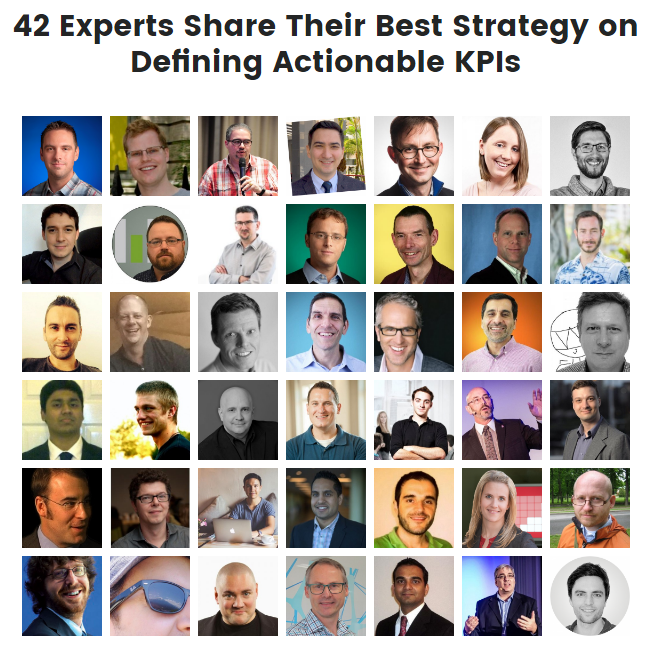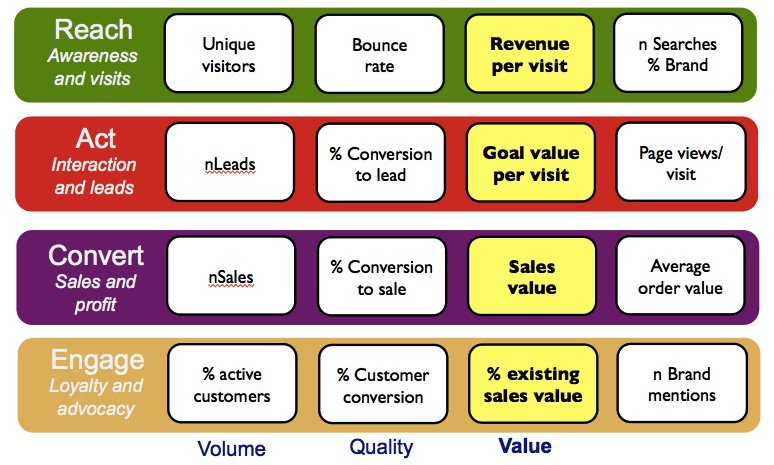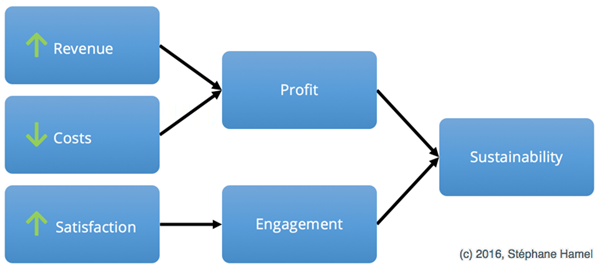Key Performance Indicators (KPIs) are probably one of the most over-used and little understood terms in business and analytics. This expert roundup post features a ton of analytics experts and demystifies how to come up with the best KPIs for your business.
“You need to define success before you can know if you’ve achieved it.”
~ Richard Branson
It’s great to read these “KPI example” posts. They can inspire you to come up with a solid set of KPIs.
However, your business, stakeholders and clients are unique and so are your KPIs.
Over the last weeks I have talked to dozens of experts to really dig deep into this topic.
Take your time to read and implement the strategies of the Analytics experts in this post. And I am 100% convinced that you will find the metrics and goals that matter most for you and your business.
A big thanks goes to the experts that have shared their knowledge and experience in this post. I wouldn’t have been able to accomplish this without them.
Let’s dive in…
 And for your convenience, a direct link to your favourite expert:
And for your convenience, a direct link to your favourite expert:
Adam Singer | Alex Clemmons | Amir Tohid | André Mafei | Andy Crestodina | Anna Lewis |
Caleb Whitmore | Carlos Escalera | Chris Meares | Damion Brown | Daniel Waisberg |
Dave Chaffey | David Kamm | Dean Levitt | Dominic Hurst | Doug Hall | Egan van Doorn |
Eric Fettman | Eric Siegel | Feras Alhlou | Franck Scandolera | Himanshu Sharma |
Jacob Knettel | Jacques Warren | Jeff Sauer | Jente de Ridder | Jim Sterne |
Jordan Louis | Judah Phillips | Jules Stuifbergen | Julian Juenemann | Manoj Jasra |
Marco Pasin | Michele Kiss | Mikko Piippo | Paolo Zanzottera | Pere Rovira |
Petri Mertanen | Rod Jacka | Sameer Khan | Stéphane Hamel | Tom van den Berg
They have all answered the following question:
“What is your number one strategy to define actionable KPIs?”
Without further ado, here are the experts…
Adam Singer, Analytics Advocate Google

“Number 1 way to getting actionable KPIs is starting with the end objective in mind and backing out what metrics accomplish this from there. I think most marketers understand this by now (certainly analysts do). More importantly, I think, is to make sure your tactical mix actually aligns directly with improving the metrics that matter for your brand. So, if you’ve determined that opt-ins to your email list are an important KPI for your brand, make sure you’re not off chasing “the tactic du-jour” that your CMO or HiPPO is excited about and stay vigilantly focused on what’s improving your goals. I’d seen time and time again as a consultant marketers lose focus and get shiny object syndrome with something new and exciting and stray from their plans. Then, at the end of the quarter or year when reviewing all our tactics and results it wasn’t a surprise why goals weren’t hit. Incidentally, this type of review will also help you tighten up your tactical mix.”
Alex Clemmons, Associate Director Analytics & Insights Cardinal Path

“Less is more – you really only want a few KPIs as the more you have the harder it becomes to know what you should pay attention to and what’s just noise. Once you’ve got the most important ones nailed down you need to be able to give them context in order to explain why they changed.
The contextual piece comes from segmenting your KPIs. For example – knowing your revenue per visitor has increased is great but knowing it was driven from new customers who clicked on a specific specific paid search keyword is better! The knowledge gained from this may allow you to alter bid strategies and thus take action on a change in your KPI.”
Amir Tohid, Co-Founder and Managing Partner Analytics Effect

“The most fundamental aspect is to understand business goals and objectives which are vital for identifying the KPIs. Every company has its own specific objectives.
I start with establishing Goals and Objectives by following the SMART principle and divide it in two categories, Short Term and Long Term.
Next step is to Identify Critical Factors which leads to success. Basically, those factors are the key activities that an organization should focus on to meet their business goals and objectives in a solid timeframe. Measures of success has to be defined for each organization.
KPIs can be extracted from those critical factors. I focus on what has changed overtime and choose metrics that help me to achieve the goal.”
André Mafei, Founder Upmize

“Ok, so, let’s start with “Why to define actionable KPIs?”, to improve the business performance, right? But the most common problem I see in my clients is not the lack of looking at some important metrics. They know that sales, ROI, profit, etc, matters. So why they have problems improving the business performance? Usually due to a lack of rich integrated data and faster tools to analyse the data. What causes them to take a long time to put data together, get insights, take action, then put the data together again to see the result of the action.
So my strategy to help my clients improve their business is by integrating the systems, building the initial reports and training their team on how to build reports by themselves. Some of the common tools I use: Tableau, Google Analytics, Google Tag Manager, Pentaho ETL.
But if you really have a team that is still not sure about their KPIs, do this: learn about their business, ask them what indicates if things are going well (KPIs), discover which numbers are necessary to calculate the KPIs, measure these numbers with a integrated system for faster analyses.”
Andy Crestodina, Co-Founder & Strategic Director Orbit Media

“Step one is simple, but most people miss it. The key is to connect your KPIs to your business objectives. Doing this will force you to ask yourself some simple, but tough questions about the metrics you may have been measuring:
- Why do we want more Facebook followers?
- What is an email subscriber worth to us?
- Do visitors from Twitter ever turn into leads?
A lot of marketers want things, but they don’t know why they want them. If you’re chasing metrics that aren’t aligned with your business goals, as yourself of those are “ego metrics.” Ask yourself if your goal is profit and success, or just fame and glory.
It would be nice to be famous, but you can’t eat fame.
Focus on KPIs that support business objectives. That’s how to pay the bills.”
Anna Lewis, Founder Polka Dot Data

“In summary: dig deep, dig deeper, then filter it to find what will make each team most successful.
I always ensure I dig as deep as possible to uncover all the potential KPIs, across the business, throughout all teams and however large and small. For some teams the KPIs are much more specific than others, so it’s very important to find all the best KPIs and then align them to the relevant teams where the data will both matter greatly to success and be something they can affect.
Once you’ve aligned the KPIs throughout the business, ensure everyone knows who has what KPIs and what can be done to affect them. This ensures accountability which helps drive action and results. If you focus on one team alone, you may find KPIs are missed, thus key data is ignored and nothing actioned as a result. Alternatively, too many people are trying things at once to improve a KPI and you end up not knowing what actually caused the impact. The final issue to avoid is setting KPIs that are very hard to have any impact or control over, this makes them a lot less actionable and they do not provide any motivation to the team to drive things forward.”
Caleb Whitmore, Founder Analytics Pros

“Before getting to KPIs, you need to back all the way up to the ‘why’ for your business and determine what the most important questions are that you need to answer. Getting to these ‘right questions’ is the hardest – and most important – part of analytics. Once you have the right questions, you’ll be able to collect the best data to answer them, and work your way up to the KPIs that are the tips of those data icebergs.”
Carlos Escalera, Founder Ohow.co

“To be able to define the right KPIs, it is essential to have a clear answer to the following questions:
- What is the objective(s) of the project, company or campaign?
- Is it possible to measure it?
- What elements can affect its achievement?
Once the objective(s) is clear and you know it is possible to measure them (generate more traffic, promote social channel, sell more products, engage readers), you can start thinking about the KPI(s) you will use to evaluate them. The first thing you need to have in mind is that all KPIs are metrics (measurable), but not all metrics can be a great KPI.
Make a list/table of all the candidates ($10k, 1k followers, 100k visitors) that your heart think will make a good KPI and answer the following questions for each of them:
- What unit will you use? (Will it be visitors or returning visitors, Followers or Shares, Revenue or Profit)
- Can you measure it?, Do you have the tools to measure it?, Which tools are you going to use?
- Is it relevant to the project?, Will it help make decisions based on it?
- Is it realistic and achievable? (Being achievable doesn’t mean that you should put a low threshold, on the contrary, you should think about the best possible outcome)
- Is it possible to follow its evolution? What would be the timeline to follow?
Once you answer these questions, discard the ones that didn’t satisfy you, and write the new ideas (most of the time this process helps you generate new KPI candidates.) and continue with this process until you are happy with the result.
There are no general rules for choosing a good KPI. It is a process that you will have to do each time, and the outcome will depend on the project, but answering these questions will help you speed it up and get much better results.”
Chris Meares, Vice-President MaassMedia

“When first engaging with clients on a new project I always start out by asking them to define the mission of their digital presence; what do you want your customers to accomplish on your digital properties? The answers that clients provide can vary wildly, and occasionally I get a dumbfounded look in response to the question because the client isn’t 100% sure. The reason I ask this question is to understand what data needs to be collected on digital properties and what the key performance indicators (KPIs) will need to be in order to measure success of their digital properties.
In order to create “actionable” KPIs, you need to have a complete understanding of what you want your users to accomplish on your digital properties. For example, an ecommerce company may have a goal of selling a product. However, beyond that, perhaps there is a support section surrounding the products that users can access to better solve their issues. The KPI for the support section is going to be completely different than the checkout process. The key to having actionable KPIs is understand the different types of success that can occur on your site, segmenting your users by those different use cases and then creating KPIs that tie directly to the successes for those use cases. In addition, each KPI should have a target that you are attempting to reach, such as a 5% increase in sales for a particular product. By having KPIs that map directly to use cases and success on your digital properties and setting targets to reach for those KPIs, you can set up your organization for digital success.”
Damion Brown, Principal Consultant Data Runs Deep

“A KPI isn’t going to be actionable if it isn’t defined properly. So the actual process of how you go about the definition is very important.
It’s a bit like that Abraham Lincoln quote, “Give me six hours to chop down a tree and I will spend the first four sharpening the axe.”
The more time you spend getting the definition of a KPI right, the more actionable it is.
Start out by thinking about the moments that matter for your business. Get a marker and a sheet of A3 and literally draw out the journey that customers take from initial awareness, through consideration, to purchase and then post-purchase.
When you’ve got your map, look for the key moments, the pivot points where really significant changes happen. It might be when someone downloads a whitepaper, signs up to an EDM, or views specific information.
These are the points at which you change in the mind of your audience.
Your KPIs need to be based on these points, and only these points. Setting goals and objectives that focus on a small number of well-defined KPIs is your sure route to staying actionable.”
Daniel Waisberg, Analytics Advocate Google

“There are two fundamental techniques you should use when defining your KPIs.
The first one, clearly described by Allison in her meaningless KPIs rant, is segmentation; there is no value in having any KPI if it is not segmented by your main audiences, personas, etc. When you use segmentation right, even the plainest KPIs (bounce rate, subscription rate, Ecommerce Conversion %) will become useful. Great segments to start with are: New vs. Returning, Acquisition Channel / Campaign, and Device Category.
The second one can be described as: do not stick to default metrics. For many years Google Analytics provided a closed set of metrics, which led many analysts to adapt their needs to fit those metrics, instead of adapting the metrics to fit their needs. Now, with the capability to create calculated metrics in Google Analytics and calculated fields in Data Studio, those days are over.”
Dave Chaffey, CEO Smart Insights

“My recommendation is that businesses need to create a structured KPI framework based around the marketing funnel or customer lifecycle. This is still a huge gap for many businesses we work with when training or consulting.
I developed the Smart Insights RACE Digital Planning framework to summarise the key online marketing activities that need to be managed as part of digital marketing. RACE covers the full customer lifecycle or marketing funnel from: (Plan) > Reach > Act > Convert > Engage.
Here’s an example of typical KPIs for which we have a Google Sheets Dashboard pulling data from the Google Analytics API: Here, the KPIs are all available in Google Analytics for an Ecommerce business, but depending on the type of business, additional measures around engagement and value are useful too.
Here, the KPIs are all available in Google Analytics for an Ecommerce business, but depending on the type of business, additional measures around engagement and value are useful too.
Our framework includes measures across audience Volume, Quality, Value and Cost. It’s important to include all of these since the default amongst businesses is to only include Volume.
So the starting point to creating a dashboard like this is to think that when you get a visit to the site, what are the outcomes you’re looking at in terms of people engaging with content? Then the outcomes, such as a lead, a contact, a download, how you’re tracking those? Then to customize Google Analytics so you can not only record those outcomes but the value of them.
For example, I was working with a travel business and what they were able to see is that when someone downloaded a brochure, that was worth say three pounds for that download. Once you’ve got that value defined, at that point you can work backwards to see which media and which content is driving those downloads. Then that gives you a way to optimise and improve your ROI.”
David Kamm, Founder & Principal Consultant iBeam Marketing Consulting Services

“My top advice for defining actionable KPIs in the context of digital marketing is to work closely with the management and leadership teams of the organization to make sure there is good agreement on what is being measured and how it impacts the business. The closer the connection between an individual marketing KPI and a financial performance variable (e.g., revenue), the more useful it is for business managers who aren’t immersed in analytics and metrics on a day-to-day basis. Indirect KPIs can also be very useful if their connections to business goals are clear.
When there is good executive-level support for the chosen KPIs, it’s much easier to secure budget and other resources for the “actionable” part: creating and adjusting campaigns, creating and modifying marketing content, adding new systems and support roles, etc. This approach also helps prevent “KPI Overkill” by limiting the key metrics to just those that are truly important to the business and the management team. The analyst team will always want to look at lower levels of detail, of course. But just because some of the sub-metrics are interesting and useful to analysts does not mean they should be included as KPIs.”
Dean Levitt, Founder Teacup Analytics

“For any key performance indicator to truly matter, and to drive action, it must be tied directly to revenue. If a KPI has a bearing on the bottom line, then it will, by default, be actionable.
It is worth mentioning that for a KPI to be actionable, it must be coupled with a reasonable goal or target at which to aim. With the ability to state where “success” is, the KPI has context and becomes actionable. Without a target, whatever you’re measuring is not an indicator but rather it is simply a metric.
If the KPI indicates poor performance, there is urgency and motivation to take corrective action. Similarly, if the KPI indicates that goals are being reached, it’s easy to justify taking further positive action. So an actionable KPI is a revenue-centric metric (or metrics) with a clearly defined target.”
Dominic Hurst, Digital Services Manager Liverpool John Moores University

“For me, we need to take this back a step. Having actionable insights is great, but having people to action them (more so want to action them) is my top strategy. A team unity, collectiveness and will to succeed needs to be planted at the start. This way the team are bought into achieving goals even setting the goals and respective KPIs.
At LJMU, Digital Services collaborate with colleagues throughout the organisation so we act as “one” when it comes to creating and defining measurement models. Whilst our measurement/ insights analysts guide colleagues through the creation process, it is very much led by those who work in the area where the goal relates too. Again creating buy-in and a will to achieve targets and action insights.
Finally we need to keep things real. Real in the sense of logical to all those who see the measurement models/ insights but also real in the sense of thinking of users. This approach is typified by Government Digital Services/ DWP and their “metrics that matter”.
Doug Hall, Director of Analytics & Conversion ConversionWorks

“Interesting question this. Especially the “actionable KPI” part. The differentiation between metrics that are actionable and those that are not is fundamental to the answer.
If you can take action based on the metric value or observing a change in the metric over time then this is a prime quality of a KPI. If a metric is not actionable, then it’s not a KPI. It might still be useful to the business in some way but if there is no action to be taken, there is no opportunity for optimisation – the number has less value to the business as it doesn’t drive change and we’re all about change, right?
Now take a closer look at the KPI in terms of actionability and (drum roll for the big score) IMPACT.
Actionability – low hanging fruit or a 12 month project? How quickly can you make change based on the KPI insights? Consider the timescales involved as a measure of prioritisation. Also, effort – as in can you make change at all? Do you need a tweak to a process to make change or do you need to reorganise the whole business? Consider the effort required to make change to qualify a KPI.
Timeliness comes second to impact. The expected impact on the business based on making change using insights from the KPI is often the deciding factor in choose the best KPIs. If a number or how a number changes can make a double digit percentage difference to your bottom line, this is going to drive your business like nothing else. Here is your gold. Cherish these numbers.
Bonus – how often should you review your KPIs? Analyst answer – “It Depends!”. Lol. But seriously, if you make a big impact change, time to review the KPIs. Find side effects of change. Remain fluid and prepare for change in your instrumentation. Don’t just sit on the same KPI suite blind to alternative, and potentially better, instruments to guide and drive your business.”
Egan van Doorn, Founder eganvandoorn.nl

“If you want to be your KPIs actionable make sure that they connect to the organizations overall business goals (duh…), but also make sure that the KPIs that you’re reporting on are the numbers that keep your boss awake at night. The numbers on which your bosses bonus depends on is a great starting point for those. Drill them down into short term tactical KPIs that make clear on a department level what the teams contribution is regarding the overall business outcome (read: the bonus of your boss). Every marketing activity or on-site optimization will now be evaluated against goal impact!”
Eric Fettman, Analytics Instructor & Coach E-Nor

“Often, it’s dimension swapping and constituencies that make your KPIs actionable.
Dimension Swapping: By this, I just mean evaluating your KPIs against different dimensions and dimension combinations. If you’re using Google Analytics, access the Mobile Overview report. Surprised to see how few visitors are submitting leads on smartphones? Don’t assume that this low conversion rate is endemic to smartphones; instead, apply Operating System as a secondary dimension. You might be even further surprised to see that your CR is much lower on iPhone than Android, but you’ve started to construct a meaningful story, and you can dig further by checking conversion rate for specific devices in the Mobile Devices report and applying Screen Resolution as the primary dimension in the Browser & OS report.
Constituencies: Create segments that map to your audience constituencies, and always evaluate your KPIs within these segments. If you run a job freelancing site or app, evaluate your “post a job” goal only for those audience members who are there to post a job. How do you create the segment? Often, it’s a user’s own behavior that indicates the constituency: users who access the “post a job” page or screen are telling you the constituency they belong to, and you can create a “behavioral” segment accordingly. Now you’ll be able to see that the conversion rate for this goal within the relevant segment is 5% instead of 1%, and that overall conversions are 50% higher than this time last year, not 10%. It’s the segmentation that facilitates the insight and prompts further analysis and action for optimization and ROI.”
Eric Siegel, Founder Predictive Analytics World

“To make the most actionable KPIs, turn them on their head: one KPI per individual, each a probability. Millions of such KPIs are what you get from predictive analytics, e.g., the chances each customer will buy, each suspect will lie, each patient will die, each debtor will default, each voter will be persuaded, etc. It does not get more actionable, since each such probability – better known as a predictive score, the output of a predictive model – directly informs the way in which to treat that individual, such as whether to call, mail, approve, test, diagnose, warn, investigate, incarcerate, set up on a date, or medicate.”
Eric Siegel is the author of Predictive Analytics: The Power to Predict Who Will Click, Buy, Lie, or Die (www.thepredictionbook.com).
Feras Alhlou, Co-Founder & Principal Consultant E-Nor

“Measure what matters most” should be a guiding principle as you’re defining your KPIs. “What matters most” will vary from one function to another, from one stakeholder to another, and it’ll also vary based on the level of maturity and sophistication of the analytics implementation and practice an organization has.
Some practitioners and consultants take the easy route and end up reporting on vanity metrics or all user interactions. Instead, take the challenging road. Build a measurement roadmap with a focus on business objectives and KPIs, then socialize the roadmap and its benefits within your organization to get buy-in from decisions makers and colleagues. Align your resources (technology, process, people) to execute on this roadmap, then share wins and share them frequently!”
Franck Scandolera, Founder webAnalyste

“What is an actionable KPI? An insightful indicator giving sufficient reason to take action. An actionable information specific enough to monitor an attribute of business performance.
So, my first strategy to define actionable and insightful KPIs is to understand the needs, the objectives and the attributes of the business activity to achieve their objectives.
The generic KPIs can’t be actionable. A marketing specialist or a CEO needs specific KPIs to monitor different facets of the business, during the particular time period, before making an important decision.
After the understanding phase is relatively easy to translate these goals in measures and data.
The other important face of actionability is the context of data visualization to tell the right story.
One figure says anything else what it represents. The context can be found, in comparison through time or item, in the relationship or distribution between dimensions.
For me, the best actionable data visualization is the time series and deviations, useful to anticipate the trend of KPIs.
In summary, an indicator must be insightful and actionable, for that, it has to be SMART (Specific, Measurable, Achievable, Relevant, Time-related) for helping an activity to achieve their business objectives. But in prior, it’s crucial to understand the business objectives.”
Himanshu Sharma, Founder Optimize Smart

“My number 1 strategy is the ‘ask question’ strategy which I explained in detail in this article: One tip that will Skyrocket your Analytics Career.
In short, I ask the client, how do they define their KPIs and why did they select those particular KPIs. The ‘why’ is very important. The goal here is to first understand their perspective, their reasoning and get an insight on why things are the way they are and not to jump to any conclusion or start making recommendations. I start my analysis with an open mind and without any prejudice.
I truly believe that my client knows a lot more about their industry and target market than I ever will. And I am here to help and not to dictate them how to run their business. When you have this type of mindset, you don’t talk like “experts”. You talk like a “clueless” person who is learning the trade.
When you talk like a clueless person, you ask a lot more questions. When you talk like an expert, you ask less questions. Your pride always stops you from asking enough questions and you are more likely to end up figuring out everything on your own, which is futile and waste of time and certainty does not conform to agile analytics methodologies.
I use my client’s years of knowledge and experience to fuel and speed up my analysis. I ask tons of questions. I keep asking questions until my client is no longer able to answer. When the client is no longer able to answer, then I start my own research to get answers to those unanswered questions, because then my analysis really matter. There is no point in spending hours and days, digging out information and insight that are already known to your client.
Once I have acquired all the knowledge I can, from the client then I match my client’s understanding about their business with my own understanding of their business, to determine “gaps”. These gaps are the conversion issues and my goals to fix. Once I have identified the conversion issues, then I determine whether the client’s chosen KPIs are a best fit to measure the performance of these goals. It is a long process. KPIs are often the result of weeks or even months of analysis and research. It is not something which can be delivered on day 1.”
Jacob Knettel, Digital Strategy Manager PFSweb

“When it comes to KPIs, I have found that the most actionable metrics are those that have either a goal or forecast to compare against. I have been in several analytics meetings where a KPI like average time on page is thrown up on a screen, but the audience has no idea if 50 seconds is a good or a bad time for how long someone is spending on a page. For an analyst to truly add value, he needs to use KPIs that he can speak intelligently to their performance and be able to further derive actionable insight from that KPI. Without a goal or forecast to compare against, the analyst is essentially driving blind and using his or her gut reaction to speak to business success or failure. If you can’t get your hands on a goal or forecast, either find benchmark data from similar websites in your industry (IBM, Adobe and Google all have benchmark features you can take advantage of) or choose a new set of KPIs.”
Jacques Warren, CEO KWANTYX

“Evaluate people (i.e. pay, promotion, heck, keeping their job!) on the KPIs, and pay them to behave accordingly. You do that, and they will care about the KPIs, the dashboards, and your analytics.“
Jeff Sauer, Founder Jeffalytics

“My #1 strategy for defining actionable KPIs is to get with the business owner and understand what they really care about. Are they interested in growth or sustainability? Are they interested in profit or market share?
Once we really understand what people are looking for in their business, you start to brainstorm Key Performance Indicators that they can use to measure the most important items.
Then comes the fun part – what I call the four T’s of analytics. After establishing KPIs, you need to get aligned with your targets, tactics, teams and tools. In that exact order.
Set targets around these KPIs that the business agrees with. Pull in tactics that can provide proven results that hit targets. Build a team and accountability for the people running the process. And last, evaluate tools that you can use to measure target performance.
Add it all together and you have not only defined actionable KPIs, you have defined a plan that is aligned with the goals of the business executives and their marketing and analytics functions. Anything else would be uncivilized.” :-)
Jente de Ridder, Web Analyst Humix

“When I start working with a new client, I don’t ask them: what are your KPIs? Experience has learned me that people often focus on the wrong metrics or just don’t have a clue at all.
Therefore, I start by organizing a “Goals Exercise”. The set-up is rather simple: get the important stakeholders together in a room for 2 hours. Hand them out a bunch of Post-Its and make them think about the purpose of their job.
Some example questions that you could ask:
- What outcome of your actions do you consider as success?
- E.g.: When my display campaign brings new visitors to the website
- How do these outcomes benefit the company?
- E.g.: It’s an opportunity to acquire new clients
- What is blocking you to achieve this outcome?
- E.g.: I’m lacking the skills to design appealing visuals
Make sure to stay away from management speak and bullshit bingo during the Goal Exercise. It works best if everyone writes down ideas in their own words.
Cluster those ideas into groups with the same underlying thought. These are the objectives that the organization should be focusing on.
I always end the “Goals Exercice” with asking the stakeholders to prioritize the objectives. This will spark a lively discussion! But in the end, you will end up with an overview of the business objectives that’s aligned and prioritized across different departments.
Then, it’s up to me to translate those objectives into actionable KPIs (e.g. % of new visitors per campaign) and define corresponding benchmarks and targets.”
Jim Sterne, President Target Marketing

“Start at the top!
What’s the one thing your executive team has been harping about lately? Are they all about growing the top line, saving money, expanding into new territories, launching new products? Chances are: all of the above. But what is their hot button? Start there and drill down.
At some point, you’ll get down to conversion rate, shopping cart value, opens and clicks but stay focused on solving business problems for as long as you can. (In between, don’t forget about those classic customer metrics of recency, frequency and monetary value.)
Find more ways to move the business needle and executives will seek out your insights.”
Jordan Louis, Web Analyst & Developer jordanlouis.ca

“Key performance indicators must be relevant to your business and the purpose of your website in it. If you’re in ecommerce, your KPIs should include metrics that relate to the art of selling things.
Dig deep with your KPIs. While many people just simply count their sales revenue, you can unlock some really useful insights that will help you optimize your business by relating one metric to another.
“Revenue per day” tells you whether there’s a particular day of week that customers buy the most on. That information could help you improve sales by running ads or promotions on slower days.
“Revenue per sale” tells you how efficient your website is at making sales. Each order costs you: buying advertising, staff to pack boxes, postage, etc. The more a customer buys in one order, the further you can stretch those costs.
Averaging out how much each customer has spent since they first visited your website tells you how much you can expect to sell to each customer. By comparing that to how much it cost you to attract each customer, you can predict how much you’ll earn with each marketing dollar spent.
Well-planned KPIs are a huge competitive advantage.”
Judah Phillips, Founder & Principal SmartCurrent

“Creating effective KPIs starts with defining the business questions that need to be informed by KPIs. It sounds so obvious, but in practice, it’s not. I’m not talking about a simple question that can be answered with data, like “what’s our weighted bounce rate by landing page by channel?” That’s not a business question. I’m talking about creating a question that drives the eventual analysis and outcome and, when answered, can help people make a decision that improves business performance. For example, “Which landing pages should we continue to use and why?” is a more helpful business question. And, sure, you could use weighted bounce rate to help frame a data – informed answer to that question. Simple, absolutely – in concept. But in reality, stakeholders may not know what questions to ask, so the better analyst in all of us should help them figure out what to ask – and then how to collect, measure, govern, and manage the resulting KPI data and eventual analysis that provides a factual answer.”
Jules Stuifbergen, Freelance Growth Marketer Stuifbergen.com

“To find actionable KPIs you should start with the action you’re going to take, and follow through from there. Formulate them like a “promise”, and commit to them as a team. Then, look at the KPI and reverse your thought process: what actions are influencing the KPI value?
Examples:
I will do more radical A/B testing when I see an upcoming local maximum which can be measured by metric Monthly Growth Rate changing to below 4% for 2 months in a row.
Growth Rate increases when you test more, better, more effective, do more research, etc.
I will stop advertising on facebook when it’s not profitable anymore which can be measured by metric Monthly Return on Ad Spend (ROAS) becomes negative.
ROAS can be increased by better targeting, cheaper CPM, better landing pages, etc.
This way, you’re putting actions first, and use KPIs as a true action monitor.”
Julian Juenemann, Founder MeasureSchool

“Being curious. Like in any Digital Analytics process we start by asking questions. Lots of them. When it comes to KPIs you first want to deeply understand the business needs, wants and outcome before attempting to slap a KPI on it. My favorite question still is “so what?” (by the infamous Avinash). “The KPI went up” So What? How will it change your organizations behaviour? What action will you take? If there are good answers to your question then the KPI will facilitate insight, action and maybe even change within an organization. So always make sure to stay curious when defining actionable KPIs.”
Manoj Jasra, Director of Digital Shaw Communications

“The most important strategy from my perspective is defining KPIs that are aligned to your organization’s overall KPIs / goals. Furthermore I have found success with taking these top-line KPIs and breaking them further down so that each person on my team truly understands the work they do and its impact to the overall organization’s success.
For example:
- Overall Organization: EBITDA / Revenue / Free Cash Flow
- Digital Organization: Online Channel Revenue / Online Revenue Mix / Online Channel Cost of Sale
- Digital Manager: Cost of Acquisition / Conversion Rate / Revenue by Product
- Digital Lead: Landing Page & Campaign Performance / Conversion by Desktop vs. Mobile”
Marco Pasin, Founder Analytics for Fun

“An actionable KPI should reproduce the most important objective of a business in a number. This way decision makers can quickly see if they are succeeding or not. To define a great KPI you need to UNDERSTAND the business or micro area you are measuring. Ask stakeholders, let them think and together figure out the best indicator tied to success. A sudden change in the KPI should create an alert and call for further analysis like segmentation.”
Michele Kiss, Senior Partner Analytics Demystified

“There are three main criteria I use when helping clients define their KPIs.
1) There can only be a few (“Key”)
If you start listing 10 or 20 different metrics, we have lost the “Key” from KPI. To constitute a KPI, it must be one of just a few select metrics that really matter.
2) It must matter if the numbers change (“Indicator”)
A spike or decline must indicate that there is a problem (or an opportunity) and spur “diagnostic mode” to find the cause. A metric that fluctuates constantly, without concern, or a stable metric that never changes – those are not KPIs.
3) You need to be able to do something about it (“Performance”)
A KPI must reflect your performance. If a metric is wholly dependent upon market forces, it is not a KPI. If a metric is out of your company’s control, it is not a KPI. (For example, you can affect revenue, but not the taxes you charge customers!) A KPI is something that you can take action upon, and that responds to your actions.”
Mikko Piippo, Analytics Consultant & Partner Hopkins Inc.

“You can never find great KPIs if you let Google Analytics limit your vision.
No matter how many Google Analytics reports you look at, no matter how you slice and segment the hits, sessions and users, your vision is too limited. You can torture the analytics reports for hours and you still can’t decide whether you should use Net Promoter Score, percentage of goods returned, number of telephone calls answered, churn or task completion rate as KPIs.
Choosing the KPIs of any organization is a strategic decision. As such we should facilitate the process of choosing them instead of trying to define the KPIs without client participation. We should also remember that the KPIs differ from department to department. Too often, the KPIs implemented and reported by web analysts are based only on the needs of marketing and sales.
So the first step for finding great actionable KPIs is to log out from Google Analytics, buy stacks of Post-it stickies and pens, schedule a series of interviews and workshops, and show your management consulting skills. It won’t be easy, but it is necessary before you can even dream of convincing the C-level to choose a set of KPIs.”
Mikko Piippo is Analytics Consultant and Partner of Hopkins Inc., Helsinki. He also blogs about Google Analytics at MikkoPiippo.com.
Paolo Zanzottera, Product Manager & Board Member ShinyStat

“In my opinion the number one strategy to define and choose your actionable KPIs is linked to two main questions every analyst and digital manager (in every digital niche) should ask before starting any digital project and investment.
#1 Question, the most important, is “Why?”: WHY am I doing this PPC campaign, WHY am I posting on Facebook, WHY have I built this website?
When you ask WHY, you’re forcing yourself to write down some objectives and goals. Try to transform the WHY answers from text to numbers: WHY am I posting on Facebook? ANSWER: I want to start a new conversation with my students to increase their knowledge and I want to create relationships with them that last longer than their university career —> This is a long and comprehensive text answer, now transform it in numbers —> I want to receive an average of 25 comments on every post from my students and I want at least 10 unique students commenting on my post. Now I like it!
So in this case I should use as KPIs #comments per post and #unique answers per post.
#2 Question: may I influence the KPIs I’ve fixed with Question #1? If you sell ice-creams you like hot and sunny days and you don’t like when it’s raining with 4°C: you know you will sell less ice creams that day, but you can’t influence the weather (not for the moment at least), so weather conditions will never be “actionable”.
In digital many times we can influence our KPIs. In this case you’ve found “Actionable KPIs”: in the example above: if I send a newsletter to the students with the link to the Facebook posts we can improve # of comments and # of people engaged. If I publish an abstract of the FB post in the University Intranet Learning Platform I can change those numbers.
An actionable KPI is a number intrinsic to the WHY of your digital project that you can directly AFFECT. An actionable KPI is “An answer to the WHY that we can CHANGE”.”
Pere Rovira, Director OneTandem

“There are no actionable KPIs without actionable objectives. So, the first thing is to create an actionable objective. For instance, many clients tell me that their objective is “To increase sales”. The problem with such an objective is that I have no clue what to do next. Should I just increase Adwords budget and hope to sell more? I don’t have context either. What does it mean to “increase sales”? When is it enough? It is very difficult to start thinking of actions if I don’t know what I want to achieve.
So I ask the client to change the way the objective is described. For instance, we might rephrase it as “Increase monthly sales by 10% compared to previous year, focusing on average order value”. Hence, I know that I need to measure two KPIs: monthly sales and average order value (AOV). I also have a target for each KPI: last year’s monthly sales and AOV. Therefore, I know what I want to change, and where I want to get. And this is to me an actionable KPI, forcing you to go from A to B.”
Petri Mertanen, Director Digital Analytics Annalect Finland

”There are so many good answers already from my peers. The very first question usually is: what should the visitors do on our website and how much money do these actions produce for the company? This is the final step of the conversion path. However, my tip is regarding the engagement part of the KPIs. I tend to ask from clients: what is the most important element on your website, home page or landing page, that visitors should click? When you tag and measure that element, you are able to create a segment of visitors who clicked and evaluate if those visitors converted better than those visitors who didn’t click. This is the first step of conversion path analysis and an important step towards conversion rate analysis. In addition to the click data, qualitative data (like heatmaps) is very useful for getting insights. With quantitative and qualitative data, you should easily get new testing ideas for the page.”
Rod Jacka, Managing Director Panalysis

“KPI is one of the most overused of all business acronyms and it is used very loosely. For something to be treated as a Key Performance Indicator it must have a direct relationship to the overall business outcome. For the KPI to be actionable it must be clearly understandable and that any changes in the indicator can be traced to one or more causes.
All too often we see businesses using very poorly thought out KPIs. The result is a lot of wasted time and unnecessary angst. (Hint: Never use bounce rate or total users or sessions as a KPI. They are important but they are not KPIs).
My number one strategy is as follows:
- Identify the business outcome that is to be measured. (e.g. total profit)
- Identify and rank all the possible influences on this (e.g. cost of goods sold, customer acquisition cost, etc)
- Identify the top influencing factors that you can control.
- Use statistical tools to identify if there is a relationship between these and the business outcome. (e.g. correlation matrix, regression analysis, etc)
- Pick the most important ones that are both controllable and have a relationship.
- Document the actions that can be taken if the KPI changes.
If you can’t control it and there isn’t a strong relationship then it is probably not worth treating as a KPI.”
Sameer Khan, Founder KeyWebMetrics

“My #1 strategy has always been and will always be to tie the KPIs to the business objectives. Business objectives should define the company’s strategic outlook and the underlying performance metrics. This will set the business for success as the leaders can rely on the KPIs measure the performance of the business and it’s progress. KPIs that are not tied to business objectives must be deleted or de-prioritized.”
Stéphane Hamel, Digital Analytics Thought Leader & Faculty Chair, Digital Analytics, SimpliLearn / Market Motive

KPI Traceability – “Traceability in the food industry refers to the ability to track all stages of production, processing and distribution. Closer to our field, traceability of data refers to the ability to track the origin, transformation and usage of data, especially when it relates to privacy.
Conversely, if you can’t trace a metric back to one of Revenue, Costs, or Satisfaction, it’s not a good KPI, as shown in the simple chart below:

Note that “Satisfaction” relates to customers, but also to investors, managers, government, or even employees – ultimately, they all have an impact on the sustainability of the business. In my workshops, I talk about Critical to Quality (CTQ). For example, if the strategy is to increase profitability, we can work on increasing revenue, or reducing costs. Metrics such as Qualified Sessions, Conversion Rate, Number of Transactions and Average Order Value would tie back to Revenue, while Cost of Goods, Transaction Fee, Returns Ratio and such would relate to Costs. From a tactical standpoint, I can’t possibly work on everything, but I can easily develop a few tactics to influence those underlying metrics.”
Tom van den Berg, Analytics & Optimization Expert Online Dialogue

“KPIs are more or less the most important subject to meet about in every company (especially big corporates). Every department has it’s own KPIs and they differ a lot between departments. Most of the times they are conflicting as well. For me the best strategy is to have a couple of clear KPIs which are set in the top of the organisation. Everybody in the organization is working together to improve these KPIs, instead of working against each other.
These KPIs should be SMART (specific, measure, attainable, relevant, time-frame) and used for a longer time so it possible to see an improvement.
And don’t forget your customers instead of only looking to numbers or percentages…”
———-
By now you are probably overwhelmed by this wealth of knowledge!
I hope you have enjoyed reading these awesome strategies as much as I do. What is your main takeaway?
Don’t forget to leave a comment and please share the post if you like it.
One last thing... Make sure to get my automated Google Analytics 4 Audit Tool. It contains 30 key health checks on the GA4 Setup.
Great round up post!
Thanks Nicole, I am glad you like it!
This is really huge but very interesting to read and learn. Will take some good amount of time to consume the entire content and all the important suggestions. Already collected couple of points which I can explore myself for our website. Thanks for sharing this post and bringing all the industry leaders and their opinions at one place.
Thanks for your comment Sonia. It might be a bit overwhelming at first, but you will discover common tips / best practices to apply to your website. Good luck and feel welcome to post any further questions here. Paul
Very informative thanks for all professional remarks..
Paul, great job with this post!
Thanks Errett, I am glad you like it!
Paul, it’s great post, bit long than I read most of the time, but worth reading.
Thanks Ron, happy to hear you like the post!
Hi Paul nice article,
I follow most of the people on twitter. It is important to define the end objective base on the the KPI. Fixing the end objective and doing a reverse engineering helps in setting milestones and reach the end objective.
Thanks for your comment Sunny. And yes, your KPIs should be closely tied to your online business objective(s).
I´m ashamed to admit that KPI was not even a very familiar term to me. This was a pretty good eye opener for me about something obviously important. Thanks!
Well Mikko, good to hear then that you have learned a lot of new things about this very important topic. Best, Paul
This is a great post, found it so useful!
Miss some names ;)
Julius Fed (Fedorovicius) – https://www.linkedin.com/in/fedorovicius/
Simo Ahava – https://www.linkedin.com/in/simoahava/
Julien Coquet – https://www.linkedin.com/in/juliencoquet/
Isaac Abramowitz – https://www.linkedin.com/in/iabramo/
Thanks for your suggestions Frank. These four people were either not top of mind or decided not to participate. :-)